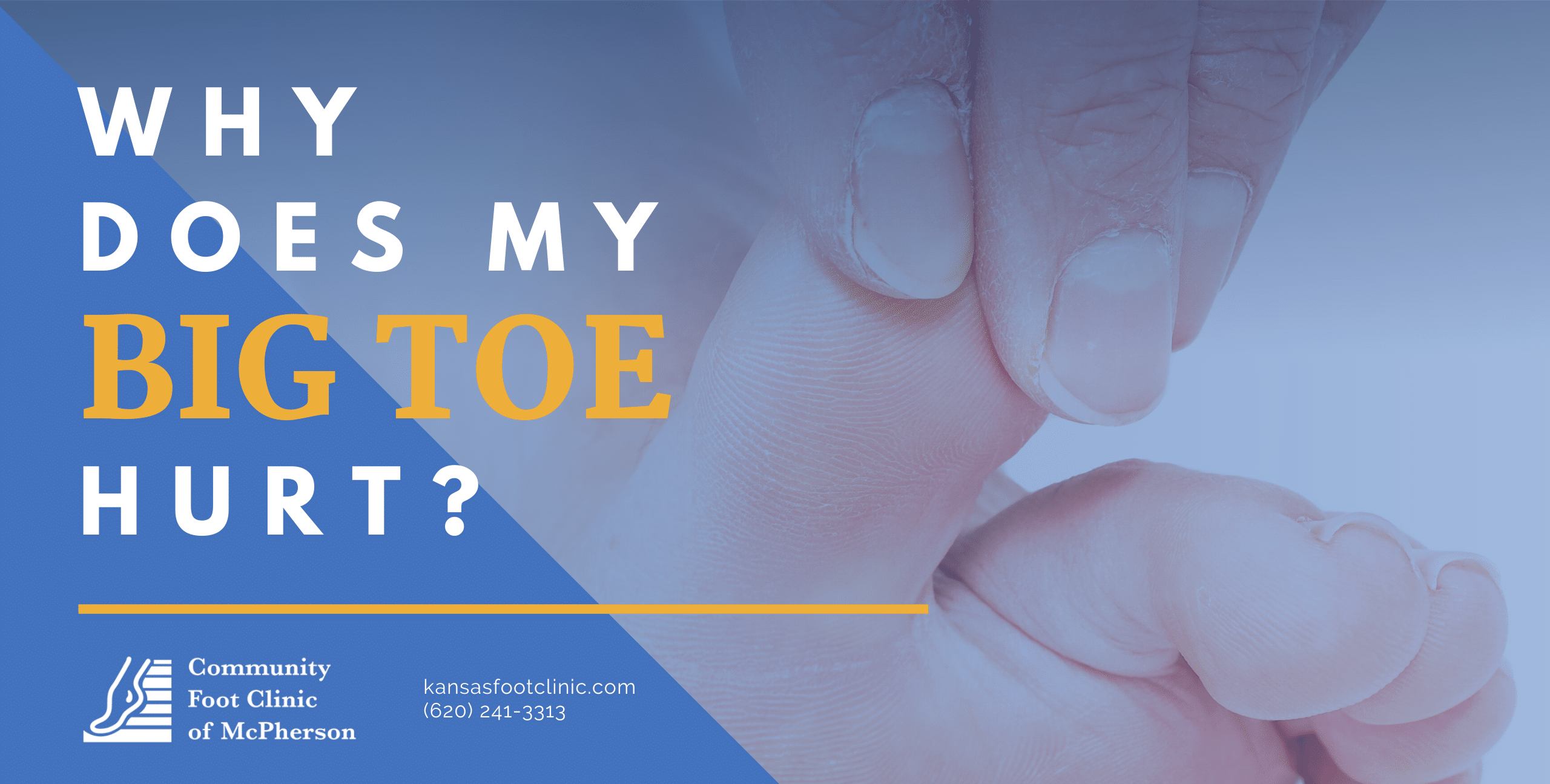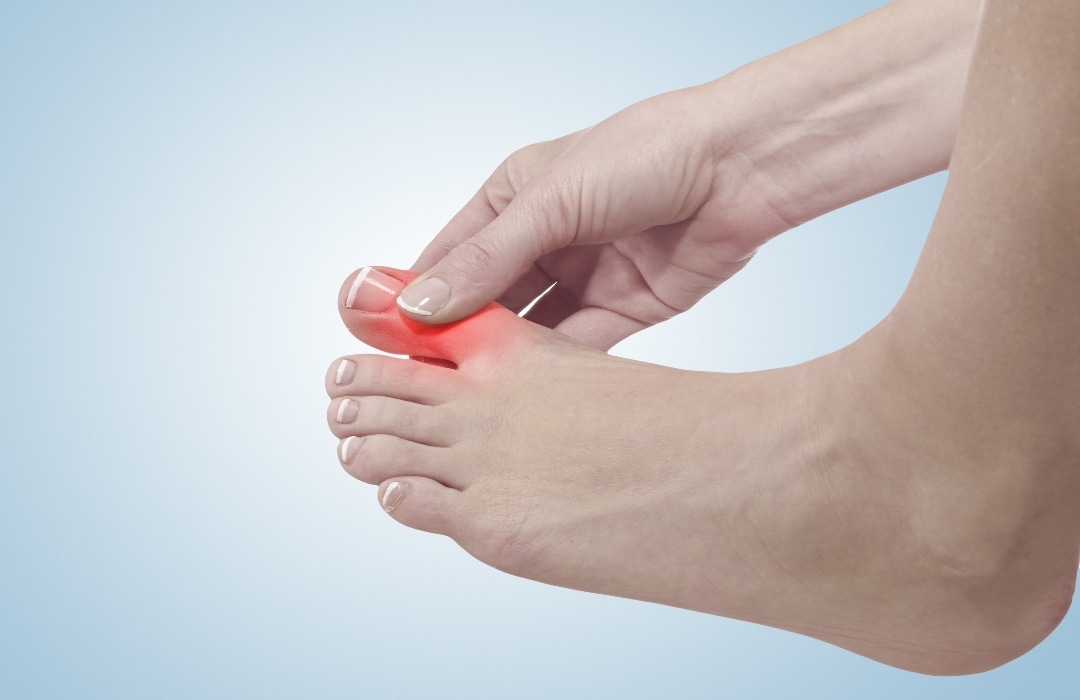Why Does My Big Toe Hurt?
Most of us don’t spend much time thinking about our toes. In fact, you might have even wondered if they really do anything for you at all.
Of course, that all changes pretty quickly if you happen to be dealing with a lot of pain in your big toe! You may realize pretty quickly how much you actually rely on your big toe for balance, stability, and support when you walk, run, or even just stand in place. Who would have thought that an injury or illness to such a small part of your body could keep you from performing even basic tasks without agony?
Of course, it’s not enough to simply know that your toe hurts. You also need to know why it hurts. And the truth is, there are many conditions that can cause significant pain in this small but important region of the body.

Identifying the Potential Culprits
Here are a few of the most common big toe aches, pains, and injuries we see at our office on a regular basis.
Turf Toe
You may have heard of turf toe befalling your favorite NFL running back, but may not know what it actually means.
On the other hand, you definitely know what an ankle sprain is—perhaps you’ve even had one or two yourself. Turf toe is also a sprain, except it occurs in the ligaments surrounding the joint at the base of the big toe, rather than the ankle.
Turf toe can happen in an instant—typically when your toe is hyperextended, as your toe goes one way and the rest of your body goes another. However, it can also develop slowly over time due to lots of running and jumping combined with shoe gear that might be too flexible in the toe area.
Telltale signs include pain, swelling, and limited joint movement. If it happens suddenly, the pain will likely be instantaneous, and it may continue to get worse and worse during the next 24 hours.
Although athletes who play on artificial turf surfaces are more susceptible—hence the name—turf toe can develop in all kinds of athletes (and non-athletes) on any surface.
Stubbed Toes
You probably don’t need us to tell you what a stubbed toe is. Almost everybody has at least one or two vivid memories of a time when they smashed a toe into a wall, table leg, bed frame, threshold, raised curb—you get the idea.
Stubbed toes are almost always painful, accompanied by throbbing pain, localized swelling, and temporary difficulty with walking or wearing shoes. The good news is that most cases are relatively minor and can be alleviated by following RICE therapy (rest, icing, compressing/wrapping the toe, and elevating the foot, especially within the first 48 hours of injury.
That being said, stubs can also cause more severe problems that might need more direct treatment from our office, especially if there are any broken or dislocated bones. Call us immediately if you notice any of the following after your stubbing incident:
- Severe pain and/or bruising
- You can’t move the toe, or moving it causes increased pain
- The toe appears deformed or out of place
- Numbness or cold sensations
- Unusually pale skin
Gout
Gout is a type of inflammatory arthritis in which “crystals” of a compound called urate build up in your bloodstream and start to accumulate in a joint. Although it’s technically possible for gout to cause pain in any joint, the big toe is by far the most common target.
Gout attacks occur suddenly at any time, even in the middle of the night. Your toe often feels like it’s “on fire,” and the pain and tenderness can be so severe that even the weight of a bedsheet causes discomfort.
Urate crystals are created when your body produces uric acid much faster than it can be filtered out, raising the concentration of uric acid in the bloodstream to unsafe levels. This can happen for several reasons, including eating a diet high in purines (which break down into uric acid), kidney problems (which may affect your body’s ability to filter uric acid efficiently), or reactions to certain medications (especially diuretics).
Osteoarthritis
The most common other form of arthritis in the big toe is osteoarthritis, otherwise known as “wear and tear” arthritis, and what most people think of when they simply hear the word “arthritis.”
Over a long period of time, the soft, rubbery cartilage that provides shock absorption and reduces friction within your joint can “grind down” and deteriorate. The body has very limited ability to repair or replace cartilage, so once it’s gone, it’s gone. This can eventually lead to “bone on bone” grinding and painful stiffness in the affected joint.
Although this process can happen naturally over time, big toes are vulnerable to post-traumatic arthritis, which is a subset of osteoarthritis affecting joints that have been previously injured. If you have a history of other toe injuries, the cartilage may wear down faster, leading to arthritic pain much earlier than elsewhere. The onset may be several years after the initial injury, but several years before other joints become arthritic.
Other Potential Causes
A few other potential causes include (but are not limited to):
- Rheumatoid arthritis. Also known by its initials (RA), rheumatoid arthritis is an inflammatory disease in which the body’s own immune system mistakenly attacks its own tissues, and in particular the lining of joints. RA often causes stiff, tender, and warm joints, possibly along with other symptoms like fever or loss of appetite. Over time, the joints may develop obvious deformities.
- Sesamoiditis. This condition doesn’t technically involve the big toe, but instead the tiny sesamoid bones located in the ball of the foot just behind the big toe. If these toes are fractured, or the tendons that attach to them become irritated, it can cause not only pain, but difficulty with straightening or bending the toe.
- Bunions. A bunion is a bony deformity that affects the joint at the base of the big toe. Over time, the joint may become arthritic, stiff, and painful. At the same time, the toe itself becomes misaligned; the tip drifts toward the second toe while a large bump forms at the base of the toe. Early detection and treatment can prevent or minimize pain and restricted motion.

Toe Pain Is Serious Business—So Don’t Delay Treatment!
Regardless of whether you think the painful symptoms you’re feeling match up well with one of the conditions above, it’s important to realize that any form of pain—including toe pain—represents a serious and urgent problem that demands closer attention!
You might feel a little nervous about whether now is really the right time to seek help. We get it! We’ve all been asked to be more careful about how, when, and why we leave the house.
But if you have pain that’s keeping you from activities, delaying evaluation and treatment may lead to more serious complications and long-term problems—in addition to threatening your quality of life in the here and now.
You do have options. One possibility is a telemedicine appointment with Dr. Timson, so you can talk about your symptoms and Dr. Timson can examine your toe via video, without you needing to leave home.
And if it is determined that an in-person visit is required, understand that we are taking your health extremely seriously and have implemented several important procedural changes to keep you safe. You can read more about them here.
Our office offers effective remedies—conservative and surgical—to address these and other toe problems, and will work hard to develop a treatment plan that’s personalized to your specific needs. Reach out to us today by dialing (620) 241-3313.
McPherson Office
316 W. 4th Street
McPherson, KS 67460
P: (620) 241-3313
F: (620) 241-6967
© Community Foot Clinic of McPherson. All Rights Reserved.
Privacy Policy | Terms & Conditions
Web Design by CP Solutions
Marketed by VMD Services
